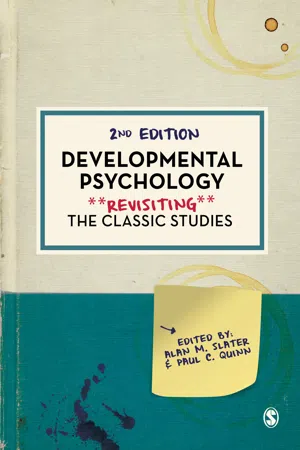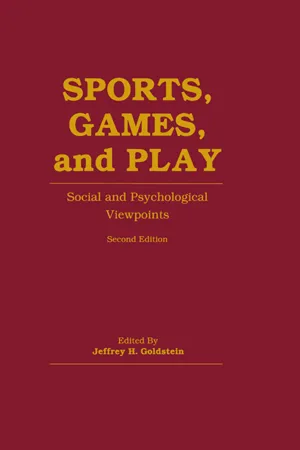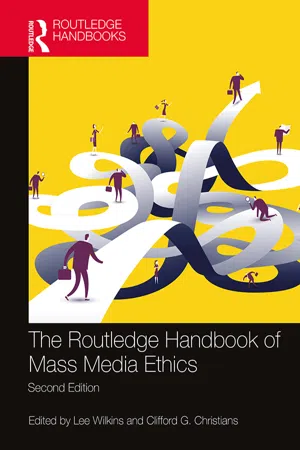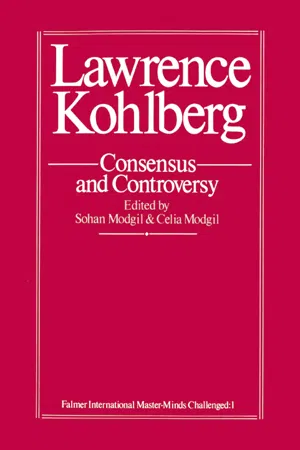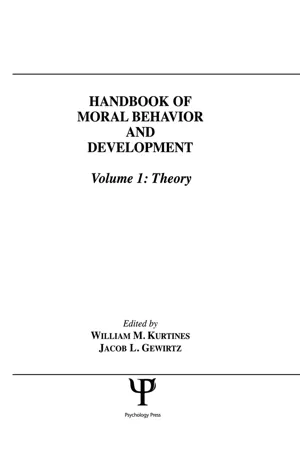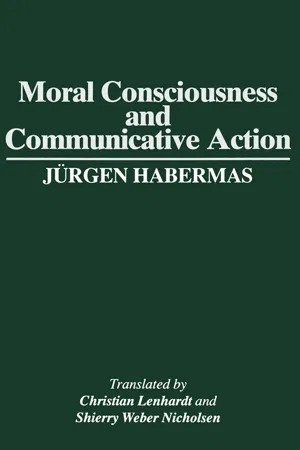Psychology
Kohlberg's Stages of Moral Development
Kohlberg's Stages of Moral Development is a theory that outlines the progression of moral reasoning in individuals. It consists of three levels - pre-conventional, conventional, and post-conventional - each with two stages. The theory suggests that individuals advance through these stages as they mature, with moral reasoning becoming more complex and principled at higher stages.
Written by Perlego with AI-assistance
Related key terms
8 Key excerpts on "Kohlberg's Stages of Moral Development"
- Wade Pickren, Donald A. Dewsbury, Michael Wertheimer(Authors)
- 2012(Publication Date)
- Psychology Press(Publisher)
Chapter 9 in this volume), who had found that cognitive development plays a part in moral development. The incorporation of Piaget’s ideas led Kohlberg to search for the cognitive-developmental foundations of universal moral principles. His 1958 dissertation proposed six stages of moral development, in contrast to Piaget’s two (heteronomy and autonomy), and took a bold stand for the validity of universal justice-oriented moral principles. He based these stages of social-moral reasoning on the understanding that mental structures or cognitive schemata are evolving within the developing brain.Subsequently, through the course of 20 years of repeated interviews with his original research participants as well as other research samples, he observed that when participants’ thought structures were inadequate to solve social-moral dilemmas, their thought structures would change in a predictable pattern of six stages. More specifically, his research suggested the following hypotheses: Each stage represents a qualitatively different way people resolve moral dilemmas. The stages form an invariant sequence: People do not skip stages or reverse their order. Kohlberg theorized that the six stages are hierarchically integrated—higher stages are better in the sense that a person who reasons at a higher stage can understand the moral reasoning used by those at lower stages—but the converse would not be true. Kohlberg also hypothesized that these stages are universal: They apply to all human beings in all cultures, even though many persons do not progress through all of the stages (Colby et al., 1983).Kohlberg’s stages of moral development were organized into three levels, with two stages each, for a total of six stages (Colby & Kohlberg, 1987; Kohlberg, 1984). Kohlberg referred to the first two stages as the level of preconventional morality because children at this level (typically aged 4 through 10 years) do not yet understand socially customary or conventional forms of morality as anything more than the arbiter of penalties for breaches in conduct. Stage 1, which Kohlberg called the punishment and obedience orientation, is evident among young children who unquestioningly orient to authority figures and believe that the physical consequences of action determine its goodness or badness. They avoid breaking rules set by external authorities for obedience’s sake, to avoid punishment, and to avoid doing physical damage to people or property. Justice is punishing the bad in terms of “an eye for an eye and a tooth for a tooth.” Kohlberg illustrated this concept by quoting his 4-year-old son who had stopped eating meat because he said it is “bad” to kill animals. One night, after Kohlberg had read him “a book about Eskimo life that included a description of a seal-killing expedition,” his son became angry and said, “There is one kind of meat I would eat, Eskimo meat. It is bad to kill animals, so it’s all right to eat Eskimos” (Kohlberg, 1981, pp. 14–15, 46, 143). Stage 2, termed individualism, instrumental purpose, and exchange- eBook - ePub
Developmental Psychology
Revisiting the Classic Studies
- Alan M Slater, Paul C Quinn, Alan M Slater, Paul C Quinn(Authors)
- 2020(Publication Date)
- SAGE Publications Ltd(Publisher)
Kohlberg’s typology included six stages grouped into three levels. Individuals begin at the lowest level and later move to higher levels, but only rarely reach the highest levels. Kohlberg referred to the first level as the Pre-Moral Level, with judgments characterized by self-interest. Within this level, a Stage 1 orientation focuses on avoiding punishment and demonstrating obedience for its own sake, and a Stage 2 orientation focuses on what Kohlberg called “naive instrumental hedonism” which is often characterized as “you scratch my back and I’ll scratch yours.” Kohlberg referred to the second level as the Morality of Conventional Role-Conformity, in which judgments are characterized by an emphasis on social relationships and an appreciation of norms and conventions. Within this level, a Stage 3 orientation focuses on maintaining positive relations with others by following expected societal standards for being good, and a Stage 4 orientation focuses on respecting laws in order to maintain social order. Kohlberg referred to the third level as Morality of Self-Accepted Moral Principles, with judgments characterized by a focus on the internally held moral principles. Within this level, a Stage 5 orientation focuses on coordinating the interest of the group with important universal values such as the need to preserve life, and Stage 6 focuses on acting according to conscience in relation to basic principles of fairness such as equality and human rights.Kohlberg found evidence of age-related change associated with the stages. The prevalence of reasoning associated with the first two stages decreased with age, reasoning associated with the second two stages increased with age and reached a plateau at age 13, and reasoning associated with the final two stages increased over time. He argued that it was necessary for individuals to pass through the stages in sequence, and that the pattern of intercorrelations he observed among the different types of moral judgments supported the notion that the higher levels of moral reasoning replace the lower levels as children develop.Kohlberg discussed points of agreement and disagreement with Piaget. He agreed with Piaget that moral development involves the construction of belief systems within the context of social interactions, rather than a passive process of internalizing external rules. He also described the relations between his stages and some of Piaget’s. For example, Kohlberg viewed his Stage 1 as closely corresponding to Piaget’s heteronomous stage, with each describing an emphasis on outcomes versus intentions and each defining what is morally right in terms of obedience to authority. Piaget viewed this account of morality as reflecting the level of respect children have for authority figures, and argued that it leads children to believe it is appropriate for adults to define what is right and wrong. In contrast, Kohlberg argued that children’s reasoning at this stage is grounded in a hedonistic desire to avoid punishment rather than respect for adult authority. Kohlberg also drew parallels between his Stage 5 and what Inhelder and Piaget (1958) described as formal operations, the most mature level in his account of cognitive development, in which reasoning is characterized by the capacity to engage in abstract thinking and deductive reasoning. Kohlberg believed that the cognitive advances associated with this stage allow children to engage in the type of hypothetical and logical reasoning that is necessary to contemplate alternative systems of social norms and think through the implications of abstract moral principles such as humanitarianism and democracy. - eBook - ePub
Sports, Games, and Play
Social and Psychological Viewpoints
- Jeffrey H. Goldstein(Author)
- 2012(Publication Date)
- Psychology Press(Publisher)
Kohlberg’s (1981, 1984) work is well known and is only briefly summarized in this chapter. His ground-breaking theory of moral development is rooted in the cognitive developmental approach to psychology most prominently associated with Piaget. Accordingly, the concept of universal stages occupies a central place in Kohlberg’s work. Within the Piagetian framework, stage progression is hypothesized to reflect an interactive process between the innate tendency of the developing child to actively organize information and an environment that demands accommodation to its features.Basic ConceptsFour key concepts can help us understand Kohlberg’s theory of moral development: moral issues, orientations, principles, and stages. Kohlberg believes that certain moral issues or values are universally recognized as important. These issues include the values of life, property, truthfulness, civil liberties, conscience, rules and laws, affiliation, authority, contract, and trust (Kohlberg, 1976). The content of moral thinking is about these moral values. Sometimes, however, one person’s claim on a particular value may come into conflict with those of others. Kohlberg (1969) wrote, “the area of conflicting claims of selves is the area of morality.” Thus, for example, if a player is asked by a coach to violate a rule, the coach’s claim of authority may conflict with the player’s claim to rule obedience.To help clarify what is involved in moral thinking, Kohlberg turns to what he calls the four universal moral orientations (Kohlberg, 1976). A moral orientation is a general approach for dealing with moral conflicts. Each moral orientation focuses on a critical element to help decide right and wrong. The first, the normative order orientation, focuses on prescribed rules and roles; decision making is guided by a consideration of rules. The consequence orientation focuses on the impact of various actions on the welfare of others and/or the self; decision making is guided by beliefs about the outcome of various behavioral options. The justice orientation focuses on the relations of liberty, equality, reciprocity, and contract between people. In decision making, this orientation is characterized by a concern for impartiality and fairness. Finally, the ideal-self - eBook - ePub
- Lee Wilkins, Clifford G. Christians(Authors)
- 2020(Publication Date)
- Routledge(Publisher)
While Piaget (1965) did his work on children, the applicability of his insights to adult moral behavior is straightforward. Adults sometimes do ethically questionable things (driving a car very fast just for the experience of speed) to see “what it would feel like.” Cooperation is the work of adult life—in families and on the job. Adults placed in novel situations—first-time parents, college graduates at the start of a career—often search for the “rule book” as a way of guiding themselves through a bewildering set of options and unanticipated need for decisions. Comfort, experience, and good cognitive skills ultimately allow most adults to internalize some universal understandings—even if those understandings are unevenly and irregularly applied. Adult life mirrors the moral judgments of the child in often uncanny and insightful ways.Piaget’s work stood for more than two decades before psychoanalyst Erik Erikson (Erikson, 1950/1963) expanded on it. Erikson’s work will be dealt with in more depth later in this chapter, but it is important to note that Erikson focused on the entire adult life cycle, not just childhood. Furthermore, Erikson postulated that each stage of moral development depended to an important degree on how the issues raised in previous stages had been resolved. Based on the work of these two psychologists, scholars accepted that moral development was both sequential and hierarchical.While many scholars have contributed to the theory of moral development, it is Harvard psychologist Lawrence Kohlberg’s six stages of moral development that is one of the most widely used today. Kohlberg (1981, 1984), who tested Piaget’s framework on undergraduate men at Harvard, proposed that these stages reflect progressively higher quality ethical reasoning, based on principles of ethical philosophy, with the higher the stage the better the reasoning. His theory rests on the assumption that some reasons used to decide ethical quandaries are better than others; good ethical thinking is not relativistic. He said that some reasons for choosing a course of action represent more comprehensive, coherent, elaborated or developed ideas, and described the course of moral development as evolving from simpler ideas to more complex ones (Rest, Narvaez, Bebeau, and Thoma, 1999a). - eBook - ePub
Theories of Development
Concepts and Applications
- William Crain(Author)
- 2015(Publication Date)
- Routledge(Publisher)
CHAPTER 7Kohlberg’s Stages of Moral DevelopmentBIOGRAPHICAL INTRODUCTION
An outstanding example of research in the Piagetian tradition is the work of Lawrence Kohlberg (1927–1987). Kohlberg focused on moral development and provided a stage theory of moral thinking that goes well beyond Piaget’s initial formulations.Kohlberg1 grew up in Bronxville, New York, and attended Andover Academy in Massachusetts, an academically demanding private high school. He did not go straight to college but instead went to help the Israeli cause, serving as the second engineer on an old freighter carrying European refugees through British blockades to Israel. After this, in 1948, Kohlberg enrolled at the University of Chicago, where he scored so high on admission tests that he only had to take a limited number of courses to earn his bachelor’s degree. This he did in one year. He stayed on at Chicago for graduate work in psychology, at first thinking he would become a clinical psychologist. But he soon became interested in Piaget and began interviewing children and adolescents on moral issues. The result was his doctoral dissertation (1958a), the first rendition of his new stage theory. Kohlberg taught at the University of Chicago from 1962 to 1968 and at Harvard University from 1968 until his death in 1987.Kohlberg was an informal, unassuming man. When he taught, he frequently came to class dressed in a flannel shirt and baggy pants—as if he had thought it was his day off. He usually began asking questions in an off-the-cuff manner. In the first days of the school year, students didn’t always know what to make of him. But they soon saw that they were in the presence of a true scholar, a man who had thought long and deeply about critical issues in philosophy and psychology, and Kohlberg was inviting them to ponder these issues with him. In his lectures and writings, he did much to help others appreciate the wisdom of the “old psychologists,” writers such as Rousseau, John Dewey, and James Mark Baldwin. - eBook - ePub
- Mark Woodward, Sohan Mogdil, Celia Mogdil(Authors)
- 1986(Publication Date)
- Routledge(Publisher)
7 There are six stages, divided into three levels: the preconventional, conventional, and postconventional stages. Nevertheless, whatever stage a person does reach, that stage is only reached after passing through the sequence of prior stages.Kohlberg’s empirical findings have been reported in a number of publications; consequently I will refrain from reviewing them in any more detail here.8 His findings have been criticized on empirical grounds in a number of places.9 Here, however, I am not concerned to question the empirical adequacy of Kohlberg’s research. Rather, I am concerned with a different question, namely: given Kohlberg’s empirical results, to what extent do they support his argument for the moral adequacy of higher stages? It is to this question I now turn.The Argument for Moral AdequacyHow does Kohlberg seek to use his research findings to justify his educational intervention programmes? He does not simply declare that what is, is what ought to be; that whatever the facts of moral development are, we ought to encourage continued (and intensified) development along those lines. This, as Kohlberg recognizes, would be an unjustifiable move, and a straightforward commitment of the naturalistic fallacy.10 Instead, Kohlberg formulates an argument that proceeds as follows:- Higher stages are more adequate psychologically than lower stages.
- There is a parallelism, or isomorphism, between the proper characterizations of the psychological and the moral adequacy of the stages.
- Therefore, higher stages are more adequate morally than lower stages.
- eBook - ePub
Handbook of Moral Behavior and Development
Volume 1: Theory
- William M. Kurtines, Jacob Gewirtz, Jacob L. Lamb(Authors)
- 2014(Publication Date)
- Psychology Press(Publisher)
I have two aims in the following elaboration of my neo-Kohlbergian view. First, I elucidate through an example the “constructive” (as opposed to “internalization”) aspects of moral development in cognitive-developmental theory, and thereby identify an internal contradiction in Kohlberg’s writings. Second, I justify my designation of stages 3 and 4 as mature on the basis of a critique of the referents of moral judgment maturity in traditional Kohlbergian theory, namely, his “postconventional” or “principled” stages (5 and 6). Refinement of the referents for Kohlberg’s general theoretical contentions is a critical prerequisite to progress toward an integration of Kohlberg’s and Hoffman’s theories of morality.Difficulties in Kohlberg’s interpretation of developmental processes and maturity are best explicated in terms of the three levels by which he classifies his six stages. Kohlberg would seem to agree that moral maturity inheres in the discernment of underlying meaning. In Kohlberg’s theory, however, “underlying meaning” has as its referent a “principled” orientation to interpersonal relationships and society. Drawing upon certain early 20th-century writings (Dewey & Tufts, 1908; McDougall, 1908), Kohlberg (1984) characterized his first two stages as the understanding and acceptance of social conventions (preconventional level); stages 3 and 4 as “conforming to and upholding the rules and expectations of conventions of society or authority just because they are society’s rules, expectations, or conventions” (p. 172; conventional level); and stages 5 and 6 as “based on formulating and accepting the general moral principles that underlie these rules” (p. 173; postconventional level; emphasis added).The postconventional level is considered “internal,” however, not only because of the discernment of underlying moral principles, but also because the moral principles are “self-chosen” (p. 173), and independent of social approval or disapproval (p. 91). - eBook - ePub
- Jürgen Habermas, Christian Lenhardt, Shierry Weber Nicholsen(Authors)
- 2015(Publication Date)
- Polity(Publisher)
stages of development.If there is no empirical evidence to suggest that we are dealing with more than one postconventional stage, Kohlberg’s description of stage 5 also becomes problematic. We may at least suspect that the ideas of the social contract and the greatest good for the greatest number are confined to traditions that hold sway primarily in England and America and that they represent a particular culturally specific substantive manifestation of principled moral judgment.Taking up certain misgivings of John Gibbs, Thomas McCarthy points out that the relation between a psychologist knowledgeable about moral theory and his experimental subject changes in a way that is methodologically significant as the subject reaches the postconventional level and takes a hypothetical attitude to his social world:The suggestion I should like to advance is that Kohlberg’s account places the higher-stage moral subject, at least in point of competence, at the same reflective or discursive level as the moral psychologist. The subject’s thought is now marked by the decentration, differentiation and reflexivity which are the conditions of entrance into the moral theorist’s sphere of argumentation. Thus the asymmetry between the prereflective and the reflective, between theories-in-action and explication, which underlies the model of reconstruction begins to break down. The subject is now in a position to argue with the theorist about questions of morality.47In the same essay McCarthy draws a useful parallel between sociomoral and cognitive development:Piaget views the underlying functioning of intelligence as unknown to the individual at lower stages of cognition. At superior levels, however, the subject may reflect on previously tacit thought operations and the implicit cognitive achievements of earlier stages, that is, he or she may engage in epistemological reflection. And this places the subject, at least in point of competence, at the same discursive level as the cognitive psychologist. Here, too, asymmetry between the subject’s prereflective know-how and the investigator’s reflective know-that begins to break down. The subject is now in a position to argue with the theorist about the structure and conditions of knowledge.48
Learn about this page
Index pages curate the most relevant extracts from our library of academic textbooks. They’ve been created using an in-house natural language model (NLM), each adding context and meaning to key research topics.

